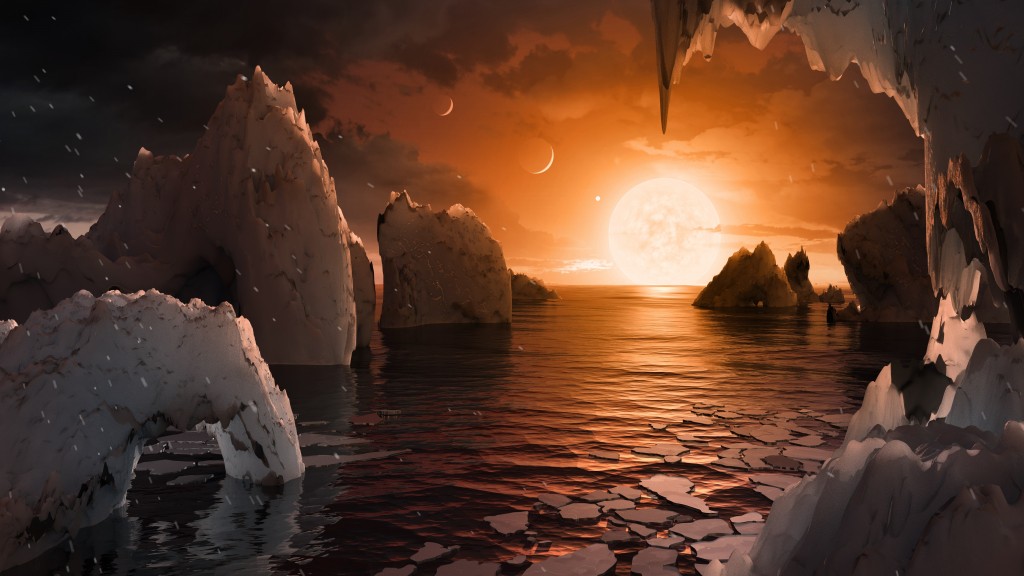NASA's Next Space Telescope Could Reveal Details About the TRAPPIST-1 Planets, But There's One Problem
Clouds will greatly impede the telescope.

The James Webb Space Telescope (Webb) could gather critical information about the atmospheres of planets in the TRAPPIST-1 planetary system, but the greatest obstacle may be clouds, one new study has found.
The search for life and worlds that could theoretically support life as we know it here on Earth depends on humans' ability to explore and study corners of the cosmos far from home. Webb, which is set to launch in 2021, has four main objectives: to detect light from the first stars and galaxies that formed in the universe, to study planetary systems, to examine the formation of stars and planetary systems, and to investigate life's origins. Scientists have hoped that, by pursuing these objectives, the telescope may also advance the search for life.
Scientists are particularly interested in the TRAPPIST-1 system because, although simulations in previous studies have shown that most of the worlds in this system are probably uninhabitable, one — TRAPPIST-1e — could host liquid water and be capable of supporting life as we know it.
Related: What Would Life Be Like on the TRAPPIST-1 Planets?
Researchers in this new study ran simulations using the TRAPPIST-1 system — a planetary system 39 light-years away that contains seven confirmed exoplanets orbiting an ultra-cool star — as a testing ground for the telescope's potential capabilities. They found that, theoretically, Webb could detect the atmospheres of all seven worlds in the system in fewer than 10 transits, or passes in front of its host star.
The team, led by Jacob Lustig-Yaeger, a doctoral student in astronomy at the University of Washington, found that the telescope could do this using an onboard tool called the Near Infrared Spectrograph.

Astronomers detect and study exoplanets like those in TRAPPIST-1 by observing when they transit their star. By studying the light that passes through a planet's atmosphere while the planet transits its star, scientists can spot variations in color and wavelength that arise when light passes through different gases in the planet's atmosphere.
Get the Space.com Newsletter
Breaking space news, the latest updates on rocket launches, skywatching events and more!
"Since each gas has a unique 'spectral fingerprint,' we can identify them and begin to piece together the composition of the exoplanet's atmosphere," Lustig-Yaeger said in a statement.
Scientists are particularly interested in the TRAPPIST-1 system because, although simulations in previous studies have shown that most of the worlds in this system are probably uninhabitable, one — TRAPPIST-1e — could host liquid water and be capable of supporting life as we know it.
However, the team found that, although Webb could detect and study the atmospheres of all the planets in TRAPPIST-1 within the telescope's first year of operation, it would be greatly impeded by clouds. "We find that transmission spectroscopy with the Near-Infrared Spectrograph Prism is optimal for detecting terrestrial, CO2-containing atmospheres, potentially in fewer than 10 transits for all seven TRAPPIST-1 planets, if they lack high-altitude aerosols," or clouds, the study's abstract states.
While it could take Webb fewer than 10 transits to detect an atmosphere on a cloud-free world in the system, it could take the telescope more than 30 transits to find a planet enveloped by thick clouds, according to the statement. But although clouds (which may or may not exist on the TRAPPIST-1 worlds) might present a challenge, they're not a complete roadblock.
"Even in the case of realistic high-altitude clouds, the James Webb telescope will still be capable of detecting the presence of atmospheres — which before our paper was not known," Lustig-Yaeger said in the same statement.
Scientists have yet to confirm which, if any, of the planets in TRAPPIST-1 have atmospheres. Webb could verify the presence of any atmospheres and even analyze their compositions.
"There is a big question in the field right now: whether these planets even have atmospheres, especially the innermost planets," Lustig-Yaeger said. "Once we have confirmed that there are atmospheres, then what can we learn about each planet's atmosphere — the molecules that make it up?"
The study was published June 21 in The Astronomical Journal.
- NASA Delays Launch of James Webb Space Telescope Again
- House Spending Bill Fires Warning Shot at James Webb Space Telescope
- TRAPPIST-1 Planet May Be Wet and Life-Friendly
Follow Chelsea Gohd on Twitter @chelsea_gohd. Follow us on Twitter @Spacedotcom and on Facebook.
Join our Space Forums to keep talking space on the latest missions, night sky and more! And if you have a news tip, correction or comment, let us know at: community@space.com.

Chelsea “Foxanne” Gohd joined Space.com in 2018 and is now a Senior Writer, writing about everything from climate change to planetary science and human spaceflight in both articles and on-camera in videos. With a degree in Public Health and biological sciences, Chelsea has written and worked for institutions including the American Museum of Natural History, Scientific American, Discover Magazine Blog, Astronomy Magazine and Live Science. When not writing, editing or filming something space-y, Chelsea "Foxanne" Gohd is writing music and performing as Foxanne, even launching a song to space in 2021 with Inspiration4. You can follow her on Twitter @chelsea_gohd and @foxannemusic.









